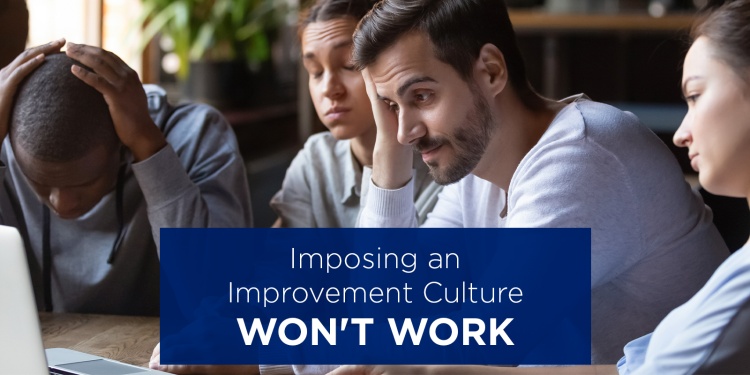
Establishing a new program or driving a culture of process and improvement can be daunting. Not only is embedding something new a marathon, but it’s also easy for teams to get derailed or lose momentum. Luckily, teams don’t have to embark on their journeys alone. They can learn what works and how to avoid impediments along the way from teams that have gone through it before.
I recently got a chance to talk to Jose Castro, the head of continuous improvement at CMI, about his session “Creating a Continuous Improvement and Process Driven Culture” which is part of the Knowledge and Process Journeys track at APQC's 2022 Process and Knowledge Management Conference, taking place May 11–12 in Houston.
What is the smartest thing your organization did to make continuous improvement and process thinking culture a success?
The smartest thing we did was listen.
You cannot impose a culture, it’s abstract and you must build a shared path from the groundup so that it's well-received and adopted. Also, as part of our efforts, we identified key cultural elements that outlined what our culture should look like. Since a culture includes building new behaviors, norms, and ideas. So, by actively listening, we could understand how those key elements benefitted not just the program, but everyone involved. Which helped drive engagement and buy-in to walk with us on the journey.
How did you identify quick wins at the beginning of your journey to create buy-in?
Listening was also very beneficial to identify quick wins.
By listening, we understood the immediate needs and could create quick ways to address them. This helped us get early buy-in. Another thing that helped get people onboard early, was that we had established our level-three process definition across the board. This is not to say those were made in a day or even a week. But they gave all of us, as a share service center at CMI, a common starting ground and engaged the leaders in the creation of the process bank, so they felt connected to the outcome. Making the processes something they owned, but that had a common foundation and was built together with the continuous improvement team.
Standardization helped us gain a lot of momentum.
It was one of the key elements that made us want to pursue this way of doing things in terms of process management and continuous improvement. CMI has multiple lines of business, so standardization is a crucial element for the success of our centralized share service center.
That’s not to say our concept of standardization is one size fits all. But we try to question the status quo and understanding whether some process best practices are applicable across the board and where they are not. Then we, we try to build the best solution, but make sure that we always follow a standard.
What would be the one thing you’d tell other organizations setting up a program NOT to do?
Don't start without knowing the problem(s).
When you start a journey like building a program you must understand the organizational needs. Unfortunately, organizations can start a program or project because that's the name it has or it's in your quarterly or yearly objectives. But with Lean Six Sigma, you don't orient efforts as managing projects, instead you focus on solving problems. This is particularly important, because if you don’t know where you're going, any road will take you there.
Nobody likes to talk about problems, but that’s the most important piece of starting any effort. You must clearly understand what the problems are by talking with leaders and decision makers to guide why you are embarking on this journey. Especially because it’s not going to be a quick journey and you will experience several hiccups along the way. But if you don't understand the problem from the very beginning and make sure the organization can see them steadily get solved, it’s going to be more difficult to achieve your goals.
What’s some advice for keeping momentum going?
Timing is everything.
When talking with my co-presenter, the continuous improvement and transformation director, we agreed that finding the right moment to start our journey was important. Timing will be unique for each organization, but you need to be cognizant on when the opportunity presents itself. In our case the share service center was mature enough to where it was the right time to do it. If we had started three years earlier, I wouldn’t be here discussing our success story, but a listing out lessons learned.
The second piece of advice is: break the journey into small bites and celebrate wins.
We're trying to make sure this is a culture and not a onetime effort of process mapping and Lean Six Sigma training. Instead, we are trying to embed this into our DNA within the share service center. So, we had seven sprints or milestones, that we review often. There was always news, discussions, and problem solving in these reviews. We referred to them as news because it's not always good news. Sometimes there are hiccups or challenges, but the important thing is that you reassess and work steadily through the entire journey. So, dividing and conquering is something that really works for us. This includes addressing problems as well as celebrating collective wins (e.g., someone get or green bell certification, an area finishes their process mapping or one of their milestones). These are the small wins that keep momentum going.
For more information on this topic check out Driving Continuous Improvement for Shared Services at CMI or join Jose and other process management experts to learn about their journeys at APQC's 2022 Process and Knowledge Management Conference, taking place May 11–12 in Houston.
For more process and performance management research and insights, follow me on twitter at @hlykehogland or connect with me on LinkedIn.